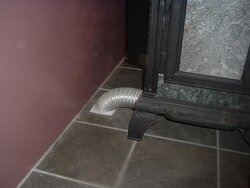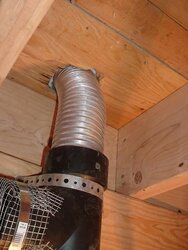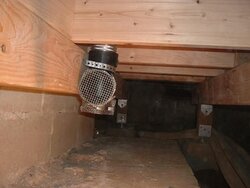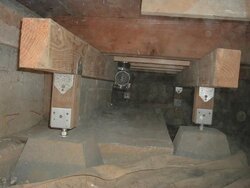On my Hearthstone stove (and maybe your stove)the details for the outside air connection include instructions to screen the inlet with 1/4" mesh to keep out farm animals among other things. I had never done it but I am having insulation installed soon and I did want to rigidy mount the inlet to something instead of just dangling down there in the crawlspace. It is important that the inlet be below the insulation level to keep things flowing. The crawlspace is vented on all sides to atmosphere.
The outside air kit has always been good for me. It constantly flows cool air into the OAK, through the stove, and up the chimney all year long.
To clamp the end of the semi-rigid aluminum duct to the beam in the photo would have been difficult to do without smashing it so I knew I needed to use a fitting and then I figured I could hose clamp the steel mesh to the fitting as well. Well, I didn't want the mesh to be a restriction so I used the tee to double the screened inlet area.
Note the remnants of the original masonry chimney in my crawlspace. I added significant structure to help support the stove and hearth.
Do you folks think that my little screen system is proper? I am not concerned with fire working its way down the tube.
The outside air kit has always been good for me. It constantly flows cool air into the OAK, through the stove, and up the chimney all year long.
To clamp the end of the semi-rigid aluminum duct to the beam in the photo would have been difficult to do without smashing it so I knew I needed to use a fitting and then I figured I could hose clamp the steel mesh to the fitting as well. Well, I didn't want the mesh to be a restriction so I used the tee to double the screened inlet area.
Note the remnants of the original masonry chimney in my crawlspace. I added significant structure to help support the stove and hearth.
Do you folks think that my little screen system is proper? I am not concerned with fire working its way down the tube.







